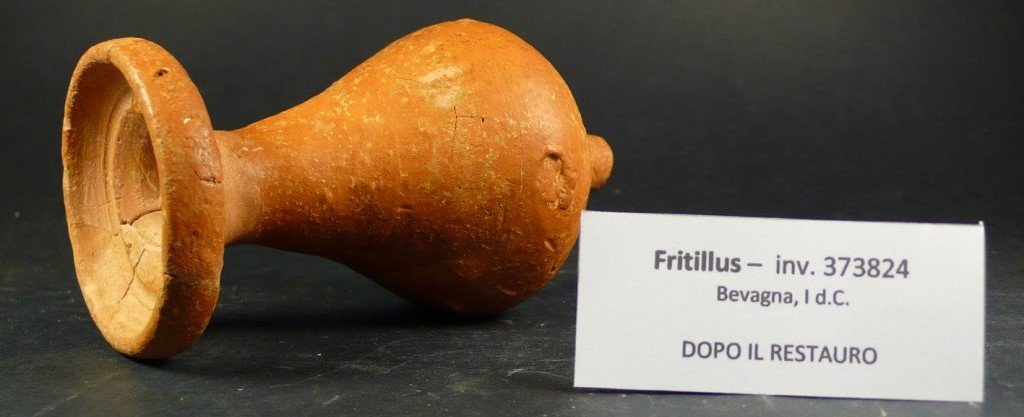Amelia International Conservation Studies
Syllabus Analyzing, Documenting and Restoring Archaeological Ceramics
Summer 2025
Mon, July 14 - Fri, August 8, 2025 (four weeks)
Amelia, Italy
Meets daily: Monday – Friday, 08:30 AM – 12:30 PM (4 weeks)
Afternoon Workshop: Monday - Friday, 2:30 PM - 6:30 PM (4 weeks)
Location: Our classroom for both lectures and workshop are situated within the cloister of St. Augustine Church, a 13th-century gem consecrated in 1288, with a Romanesque-Gothic façade).
Lead Instructor: Nicola Pagani
No prerequisites required.
Catalog Description:
Theoretical overview of traditional ceramic technology and its evolution. Examine materials and production methods used in the Mediterranean basin. Study historical typologies of ceramics and pottery found in Italy.
Theoretical knowledge and practical skills in the field of conservation of archaeological pottery. Students learn various methods of cleaning pottery sherds, the reassembly of pottery from surviving sherds, in-filling gaps left in the pottery after reassembly, the aesthetic treatment of the infilling for display and how to document the restoration procedure on pottery.
Theoretical lecture on the use of 3d technologies for the documentation and reproduction and restoration of ceramic artifacts. analysis of some case studies and evaluation of the actual possibilities of the use of such tools.
Practical demonstration of the use of a portable infrared light 3d scanner and use of filament 3d printer for prototyping.
Student Learning Outcomes:
Students who successfully complete this course will be able to:
• Document analyze and asses sherds
• Analyze appropriate cleaning methods and apply them to pottery
• Assess sherds and reassemble pottery
• Evaluate various in-fill methods and apply them to pottery
• Evaluate aesthetic aspects of infill treatment
• Document the restoration process
Grade Breakdown:
Field work: 50%
As part of the field work project students will complete various assignments including:
analysis of the state of conservation of the object, proposal of the possible conservation treatments, and the hands-on practical intervention and treatment (cleaning, consolidation, restoration, etc.).
Graded on quality and completeness of analysis, proposed intervention plan, and hands-on treatment of object.
Assignments:
Term Paper: 50%
Compilation of the Conservation Form including, description of object, detailed description of restoration work, explanations of methods and techniques used, and explanation of why a particular approach was implemented.
Four page conservation form and eight-page conservation report (50%).
Your paper will be evaluated on content, organization, and clarity.
Grading scale:
94-100 = A
90-93 = A-
87-89 = B+
84-86 = B
80-83 = B-
77-79 = C+
74-76 = C
70-73 = C-
67-69 = D+
64-66 = D
60-63 = D-
Below 60 = F
Late Assignment Policies:
The practical projects may be completed in any order as there is no individual deadline, but ALL work must be completed by the final day of class in Amelia, Italy. The workshop lab is dismantled the following day after the program ends and students will not have access to materials or lab space. No work is accepted after the last day of class.
The Conservation Form must be consigned within a week of the final day.
Lecture Topics:
The shift to subjective and intangible needs in conservation. From the experts’ zone to the trading zone: the emergence of the subject.
Clashes in meanings: inter and intra-cultural issues in conservation.
From the conservation of truth to the conservation of meanings and the value-led conservation.
Introduction to the theory of restoration in Italy: conservation-restoration and preservation. Definitions.
Introduction in the identification of major ancient ceramic forms
Study of the main crafting techniques of ancient ceramic
Ceramics decay and deterioration
Ceramic conservation
Cleaning techniques and materials
Consolidation techniques and materials
Fragments search methodology
Gap filling, surface protection and supports
Aesthetic treatment of the fillings with the “dots techniques”
Handling and moving objects of art
Museum and storage environments
Packing and display materials
Exhibition supports and examples of exposition methods
3d technologies for the documentation and restoration of cultural heritage
Site study visits
The lectures may be concentrated in the morning in relation of the needs of the course, and the study visits may be in other days depending on the availability of the museums.








